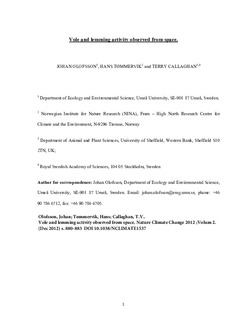Vole and lemming activity observed from space
Journal article, Peer reviewed
Accepted version

Åpne
Permanent lenke
http://hdl.handle.net/11250/2561481Utgivelsesdato
2012Metadata
Vis full innførselSamlinger
- Publikasjoner fra CRIStin - NINA [2397]
- Scientific publications [1423]
Sammendrag
Predicting the impacts of present global warming requires an understanding of the factors controlling plant biomass and production. The extent to which they are controlled by bottom-up drivers such as climate, nutrient and water availability, and by top-down drivers such as herbivory and
diseases in terrestrial systems is still under debate1. By annually recording plant biomass and community composition in grazed control plots and in herbivore-free exclosures, at 12
sites in a subArctic ecosystem, we were able to show that the regular interannual density fluctuations of voles and lemmings drive synchronous interannual fluctuations in the biomass of
field-layer vegetation. Plant biomass in the field layer was between 12 and 24% lower the year after a vole peak than the year before, and the combined vole and lemming peaks are visible as a reduced normalized difference vegetation index in satellite images over a 770 km2 area in the following year,
despite the wide range of abiotic, biotic and anthropogenic forces that influence the vegetation2–5. This strongly suggests that the cascading effect of rodents for the function and diversity of tundra plant communities needs to be included in our scenarios of how these ecosystems will respond to
environmental changes.